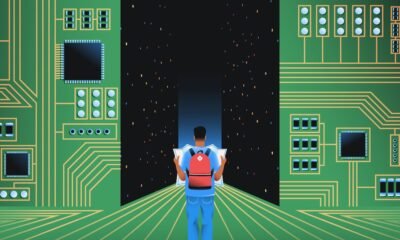Tools & Platforms
New AI guidance for teachers in Mass – NBC Boston

Artificial intelligence in classrooms is no longer a distant prospect, and Massachusetts education officials on Monday released statewide guidance urging schools to use the technology thoughtfully, with an emphasis on equity, transparency, academic integrity and human oversight.
“AI already surrounds young people. It is baked into the devices and apps they use, and is increasingly used in nearly every system they will encounter in their lives, from health care to banking,” the Department of Elementary and Secondary Education’s new AI Literacy Module for Educators says. “Knowledge of how these systems operate—and how they may serve or undermine individuals’ and society’s goals—helps bridge classroom learning with the decisions they will face outside school.”
The Department of Elementary and Secondary Education released the learning module for educators, as well as a new Generative AI Police Guidance document on Monday ahead of the 2025-2026 school year, a formal attempt to set parameters around the technology that has infiltrated education.
Both were developed in response to recommendations from a statewide AI Task Force and are meant to give schools a consistent framework for deciding when, how and why to use AI in ways that are safe, ethical and instructionally meaningful, according to a DESE spokesperson.
Artificial intelligence promises ways to change our lives, but a new watchdog group report found that it can also tell teenagers to do things like get drunk or high, go on a crash diet or compose a suicide note. Political commentator Sue O’Connell discusses how the technology is regulating AI for safety
The department stressed that the guidance is “not to promote or discourage the use of AI. Instead, it offers essential guidance to help educators think critically about AI — and to decide if, when, and how it might fit into their professional practice.”
The learning module for educators itself notes that it was written with the help of generative AI.
The first draft was intentionally written without AI. A disclosure says “the authors wanted this resource to reflect the best thinking of experts from DESE’s AI task force, from DESE, and from other educators who supported this work. When AI models create first drafts, we may unconsciously ‘anchor’ on AI’s outputs and limit our own critical thinking and creativity; for this resource about AI, that was a possibility the authors wanted to avoid.” However, the close-to-final draft was entered into a large language model like ChatGPT-4o or Claude Sonnet 4 “to check that the text was accessible and jargon-free,” it says.
In Massachusetts classrooms, AI use has already started to spread. Teachers are experimenting with ChatGPT and other tools to generate rubrics, lesson plans, and instructional materials, and students are using it to draft essays, brainstorm ideas, or translate text for multilingual learners. Beyond teaching, districts are also using AI for scheduling, resource allocation and adaptive assessments.
Mike Proulx discusses the latest updates for OpenAI’s latest version of ChatGPT
But the state’s new resources caution that AI is far from a neutral tool, and questions swirl around whether AI can be used to enhance learning, or short-cut it.
“Because AI is designed to mimic patterns, not to ‘tell the truth,’ it can produce responses that are grammatically correct and that sound convincing, but are factually wrong or contrary to humans’ understanding of reality,” the guidance says.
In what it calls “AI fictions,” the department warns against over-reliance on systems that can fabricate information, reinforce user assumptions through “sycophancy,” and create what MIT researchers have described as “cognitive debt,” where people become anchored to machine-generated drafts and lose the ability to develop their own ideas.
The guidance urges schools to prioritize five guiding values when adopting AI tools: data privacy and security, transparency and accountability, bias awareness and mitigation, human oversight and educator judgment, and academic integrity.
On privacy, the department recommends that districts only approve AI tools vetted through a formal data privacy agreement process and teach students how their data is used when they interact with such systems. For transparency, schools are encouraged to inform parents about classroom AI use, maintain public lists of approved tools, and describe how each is used.
Bias is another central concern. The guidance suggests generative AI tools have built-in harmful biases, as they are trained on human data, and that teachers and students should examine how AI responses may vary.
“When AI systems go unexamined, they can inadvertently reinforce historical patterns of exclusion, misrepresentation, or injustice,” the department wrote.
This job market can be tough, especially for young people trying to break into it — and the tech used to find and land a job now looks totally different from before. So how do parents help their kids? Hirevue CIO Nathan Mondragon explains.
Officials warn that predictive analytics forecasting a student’s future outcome could incorrectly flag them for academic intervention, based on biased AI interpretation of data.
“Automated grading tools may penalize linguistic differences. Hiring platforms might down-rank candidates whose experiences or even names differ from dominant norms. At the same time, students across the Commonwealth face real disparities in access to high-speed internet, up-to-date devices, and inclusive learning environments,” the guidance says.
The document also places responsibility on educators to oversee and adjust AI outputs. For example, teachers might use AI to draft a personalized reading plan but still adapt it to reflect a student’s individual interests, such as sports or graphic novels.
For students, the state is moving away from a tone of outright prohibition of AI, and towards one of disclosure for the sake of academic integrity.
The documents suggest that schools could come up with policies for students to include an “AI Used” section in their papers, clarifying how and when they used tools, while teachers teach the distinction between AI-assisted brainstorming and AI-written content.
“Schools teach and encourage thoughtful integration of AI rather than penalizing use outright… AI is used in ways that reinforce learning, not short-circuit it. Clear expectations guide when and how students use AI tools, with an emphasis on originality, transparency, and reflection,” it says.
Beyond classroom rules, it emphasizes that “AI literacy” — not only the technical knowledge, but understanding and evaluating the responsible use of these tools — as an important job and civic skill.
“Students need to be empowered not just as users, but as informed, critical thinkers who understand how AI works, how it can mislead, and how to assess its impacts,” the guidance says.
That literacy extends to the personal and environmental costs of technology. Students, the department suggests, should reflect on their digital footprints and data permanence while also considering environmental impacts of AI like energy use and e-waste.
The new resources emphasize that “teaching with AI is not about replacing educators—it’s about empowering them to facilitate rich, human-centered learning experiences in AI-enhanced environments.”
The classroom guidance arrives as Gov. Maura Healey has taken a prominent role in shaping Massachusetts’ AI landscape. Last year she launched the state’s AI Hub, calling it a bid to make Massachusetts a leader in both developing and regulating artificial intelligence. Healey has promoted an all-in approach to integrating AI across sectors, highlighting its potential for economic development.
Education officials positioned their new resources as part of that broader statewide strategy.
“Over the coming years, schools will play a critical role in supporting students who will be graduating into this ecosystem by providing equitable opportunities for them to learn about the safe and effective use of AI,” it says.
The documents acknowledge that AI is already embedded in many of the tools students and teachers use daily. The challenge, they suggest, is not whether schools will use AI but how they will shape its role.
The release also comes against the backdrop of a push on Beacon Hill to limit technology in classrooms.
The Senate this summer approved a bill that would prohibit student cellphone use in schools starting in the 2026-2027 academic year, reflecting growing concern that constant device access hampers focus and learning. Lawmakers backing the measure have likened cellphones in classrooms to “electronic cocaine” and “a youth behavioral health crisis on steroids.”
The House has not said when it plans to take up the measure, or even when representatives will return for serious lawmaking, a timetable that now appears likely to fall after the new school year begins. That uncertainty leaves schools in a period of flux, weighing how to integrate emerging AI tools even as lawmakers consider pulling back on other forms of student technology use.
Tools & Platforms
xAI sues former engineer for allegedly stealing ChatGPT-beating technology

Elon Musk’s artificial intelligence company xAI filed a federal lawsuit on August 28, 2025, against former engineer Xuechen Li, alleging theft of confidential information containing “cutting-edge AI technologies with features superior to those offered by ChatGPT.” The 29-page complaint filed in the Northern District of California seeks damages and emergency injunctive relief to prevent Li from working at OpenAI while the case proceeds through court.
Li, who joined xAI in February 2024 as one of approximately 20 initial engineers, had “access to and responsibility for components across the entirety of xAI’s technology stack,” according to court documents. The complaint alleges Li uploaded proprietary data to personal storage systems on July 25, 2025, three days before resigning to accept a position at OpenAI with an August 19 start date.
Subscribe PPC Land newsletter ✉️ for similar stories like this one. Receive the news every day in your inbox. Free of ads. 10 USD per year.
The timing proves particularly damaging for xAI’s case. Li sold approximately $7 million in company stock through two transactions facilitated by xAI itself – receiving $4.7 million on July 23 and $2.2 million on July 25, the same day he allegedly copied confidential files. Court filings reveal that xAI facilitated the second transaction “because xAI valued his contributions, and wanted to retain him as a productive and successful employee.”
Li’s alleged misconduct emerged during routine security reviews after he departed the company. According to the complaint, Li “admitted in a handwritten document he provided to xAI that he misappropriated xAI’s Confidential Information and trade secrets.” The admission occurred during meetings at Winston & Strawn’s offices in Redwood City on August 14 and 15, 2025, with his criminal defense attorney present.
The legal documents detail Li’s efforts to conceal his activities. He “deleted his browser history and system logs, renamed files, and compressed files prior to uploading them to his Personal System,” according to the complaint. Li also changed critical account passwords on August 11, 2025, after receiving xAI’s demand letter, then claimed he could not “remember” the new credentials during subsequent negotiations.
The lawsuit emerges amid intense competition for AI talent between major technology companies. Recent litigation trends highlight escalating disputes over intellectual property and market control in the artificial intelligence sector. The case follows multiple high-profile legal battles involving AI companies and content creators over training data usage and copyright protection.
xAI’s complaint emphasizes the extraordinary financial investment required for AI development. The company states that “advanced AI models can cost greater than hundreds of millions of dollars to develop,” with xAI investing billions in its intellectual property development. The lawsuit notes that “maintaining the utmost secrecy in the development of AI models is of critical importance” given the competitive landscape.
The stolen information allegedly relates to Grok, xAI’s conversational AI system launched in November 2023. Court documents describe Grok 4 as “one of the most, if not the most, advanced and powerful generative AI systems in the world, leading industry benchmarks in reasoning and pretraining capabilities.” The technology enables natural language processing, image generation, and audio response capabilities.
Market dynamics underscore the lawsuit’s significance for the AI industry. According to xAI’s filings, “experts predict that the market value of AI technology will exceed hundreds of billions of dollars this year, and over a trillion dollars by decade’s end.” The complaint notes that OpenAI currently controls “over 80 percent of the generative AI chatbot market” after ChatGPT’s November 2022 launch sparked widespread adoption.
Li signed comprehensive confidentiality agreements upon joining xAI, including an Employee Confidential Information and Invention Assignment Agreement defining protected information. The agreement covers “trade secrets, proprietary technology, inventions, mask works, ideas, processes, formulas, software in source or object code, data, programs” and other technical materials.
Additionally, Li executed a Termination Certificate on August 1, 2025, falsely representing compliance with confidentiality obligations. The document required him to certify returning all company materials and deleting any confidential information from personal systems. Court filings reveal these representations were “knowingly false” as Li retained xAI’s proprietary data.
The case highlights broader tensions within the AI industry over employee mobility and trade secret protection. xAI’s complaint argues the stolen secrets “could save OpenAI and other competitors billions in R&D dollars and years of engineering effort, handing any competitor a potential overwhelming edge in the race to dominate the AI landscape.”
xAI implemented extensive security measures to protect its intellectual property, including SOC 2 Type II compliance, NIST 800-171 Rev.3 framework adoption, security awareness training, background checks, and endpoint encryption. The company maintains dedicated information security teams and conducts regular assessments to protect confidential materials.
Buy ads on PPC Land. PPC Land has standard and native ad formats via major DSPs and ad platforms like Google Ads. Via an auction CPM, you can reach industry professionals.
The lawsuit seeks temporary restraining orders requiring Li to surrender personal devices for forensic examination and preventing his employment at OpenAI until all confidential information is deleted. xAI also requests permanent injunctions against disclosure or use of its trade secrets, plus monetary damages, attorneys’ fees, and punitive damages.
Legal experts note the case’s potential impact on AI industry employment practices. The lawsuit challenges common talent mobility patterns while testing courts’ willingness to restrict employee movement between competing AI companies. The outcome could establish precedents for protecting proprietary AI technologies through contractual and legal mechanisms.
Li’s case follows recent AI-related litigation trends, including privacy disputes over meeting recording technologies and regulatory challenges to content moderation requirements. Courts increasingly confront complex questions about AI development, intellectual property protection, and competitive practices within rapidly evolving technology markets.
The Northern District of California court will determine whether xAI’s emergency relief requests merit temporary restrictions on Li’s employment while the underlying trade secret claims proceed to trial. The case represents one of the most significant AI trade secret disputes to emerge from Silicon Valley’s competitive talent marketplace.
Subscribe PPC Land newsletter ✉️ for similar stories like this one. Receive the news every day in your inbox. Free of ads. 10 USD per year.
Timeline
- February 26, 2024: Xuechen Li begins employment at xAI as Member of Technical Team, signing confidentiality agreement
- June 2025: Li sells $4.7 million in xAI stock through company-facilitated transaction
- July 23, 2025: Li receives cash proceeds from first stock sale ($4.7 million)
- July 25, 2025: Li receives additional $2.2 million from second stock sale and allegedly uploads confidential xAI data to personal systems
- July 28, 2025: Li suddenly resigns from xAI, having already accepted position at OpenAI
- August 1, 2025: Li signs false Termination Certificate claiming compliance with confidentiality obligations
- August 11, 2025: xAI discovers Li’s data theft during routine security review and sends demand letter; Li changes critical account passwords
- August 14-15, 2025: Li admits to theft in meetings with criminal defense attorney present at Winston & Strawn offices
- August 18, 2025: Li signs Authorization agreement but provides incomplete account access information
- August 19, 2025: Li’s scheduled start date at OpenAI
- August 28, 2025: xAI files federal lawsuit in Northern District of California
- August 29, 2025: Musk’s xAI files additional antitrust lawsuit against OpenAI and Apple
Subscribe PPC Land newsletter ✉️ for similar stories like this one. Receive the news every day in your inbox. Free of ads. 10 USD per year.
Summary
Who: xAI Corp. and X.AI LLC filed lawsuit against former engineer Xuechen Li, a Chinese national and Stanford PhD who worked as one of xAI’s first 20 engineers.
What: Federal lawsuit alleging trade secret theft, breach of contract, fraud, and computer access violations. xAI claims Li stole “cutting-edge AI technologies with features superior to those offered by ChatGPT” and seeks injunctive relief to prevent his employment at OpenAI.
When: Lawsuit filed August 28, 2025, following alleged data theft on July 25, 2025, and Li’s resignation on July 28, 2025. Critical events occurred between Li’s stock sales in June-July 2025 and his planned August 19 start date at OpenAI.
Where: Case filed in US District Court for Northern District of California (Case No. 3:25-cv-07292). Li worked at xAI’s Palo Alto headquarters and resides in Mountain View, California.
Why: xAI argues Li’s theft threatens its competitive position in the AI market worth hundreds of billions annually. The stolen technology could save competitors “billions in R&D dollars and years of engineering effort,” potentially undermining xAI’s market expansion strategy and product development roadmap.
PPC Land explains
xAI: Elon Musk’s artificial intelligence company founded in 2023, developing the Grok conversational AI system. The Nevada-based corporation operates from Palo Alto, California, and positions itself as a competitor to OpenAI’s ChatGPT with claims of superior reasoning capabilities. According to court documents, xAI has invested billions in developing its proprietary AI technology and achieved significant market recognition within two years of operation.
Trade Secrets: Confidential business information that derives economic value from not being generally known to competitors. In AI development, trade secrets encompass model weights, training methodologies, system prompts, algorithmic improvements, and technical know-how. The lawsuit emphasizes that trade secrets protect “nearly all of xAI’s developments” including cutting-edge technologies with features allegedly superior to competing products like ChatGPT.
OpenAI: The artificial intelligence research company behind ChatGPT, currently controlling over 80 percent of the generative AI chatbot market according to court filings. Founded as a research organization, OpenAI has evolved into a commercial entity offering AI services through its GPT models. The company represents Li’s new employer and xAI’s primary competitor in the conversational AI marketplace.
Confidential Information: Legally protected proprietary data covered under employment agreements, including technical specifications, business strategies, financial data, and developmental processes. Court documents define this broadly as “any and all confidential knowledge, data or information” that competitors could use for competitive advantage. Li’s confidentiality agreement specifically covered inventions, software code, and non-public information relating to xAI’s operations.
Grok: xAI’s flagship conversational AI system launched in November 2023, described in court documents as “one of the most advanced and powerful generative AI systems in the world.” The technology performs natural language processing, image generation, and audio response functions. The latest version, Grok 4, allegedly leads industry benchmarks in reasoning and pretraining capabilities, representing billions in development investment.
Misappropriation: The unauthorized acquisition, disclosure, or use of trade secrets by someone with access to confidential information. Federal law defines this as obtaining trade secrets through improper means including theft, misrepresentation, and breach of confidentiality duties. The lawsuit alleges Li misappropriated xAI’s proprietary technology by copying files to personal systems without authorization, then concealing his actions through technical cover-up methods.
Artificial Intelligence: Computer systems designed to perform tasks typically requiring human intelligence, including learning, reasoning, and problem-solving. The lawsuit emphasizes AI’s transformative impact, noting that generative AI adoption occurred faster than personal computers or internet adoption. Market projections estimate AI technology value exceeding hundreds of billions in 2025, reaching over one trillion dollars by decade’s end.
ChatGPT: OpenAI’s conversational AI chatbot launched in November 2022, powered by generative pre-trained transformer models including GPT-3.5, GPT-4, and GPT-o3. The service marked widespread public access to conversational AI tools and achieved rapid market dominance. Court documents position ChatGPT as the primary competitive benchmark against which xAI measures Grok’s superior features and capabilities.
Federal Lawsuit: Legal action filed in United States District Court alleging violations of federal statutes including the Defend Trade Secrets Act, Computer Data Access Fraud Act, and breach of contract claims. The Northern District of California case seeks monetary damages, injunctive relief, and emergency orders preventing Li’s employment at OpenAI. Federal jurisdiction applies because the case involves interstate commerce and federally protected intellectual property rights.
Injunctive Relief: Court orders requiring parties to perform or refrain from specific actions, typically granted when monetary damages prove inadequate to address ongoing harm. xAI seeks temporary restraining orders preventing Li from working at OpenAI, accessing personal devices containing stolen data, and disclosing confidential information. The company argues that immediate court intervention is necessary to prevent irreparable competitive damage and protect proprietary technology investments.
Tools & Platforms
US health insurance agency to use AI for authorising patient claims; how this may be a problem

The Centers for Medicare and Medicaid Services (CMS), a federal agency responsible for health insurance services in the US, has announced a new artificial intelligence (AI) based pilot program. A press release issued by the agency states that this AI-powered program will be used to assess the “appropriateness” of certain medical services. According to a report by The New York Times, the program is scheduled to begin in six states by 2026, which will apply prior authorisation to a group of Original Medicare recipients. According to a CMS press release, the AI algorithms will be used to ensure that care recipients are not receiving “wasteful, inappropriate services.” The pilot program aims to target these services in Original Medicare, a process that is already common for those with Medicare Advantage.As per the report, similar AI-based algorithms like these have already faced litigation, adding that the AI companies involved “would have a strong financial incentive to deny claims.” The new pilot has even been described as an “AI death panels” program by the report.‘
What the agency said about this AI-based program
In the press release, CMS wrote: “The Centers for Medicare & Medicaid Services (CMS) is announcing a new Innovation Center model aimed at helping ensure people with Original Medicare receive safe, effective, and necessary care.Through the Wasteful and Inappropriate Service Reduction (WISeR) Model, CMS will partner with companies specializing in enhanced technologies to test ways to provide an improved and expedited prior authorization process relative to Original Medicare’s existing processes, helping patients and providers avoid unnecessary or inappropriate care and safeguarding federal taxpayer dollars.The WISeR Model will test a new process on whether enhanced technologies, including artificial intelligence (AI), can expedite the prior authorization processes for select items and services that have been identified as particularly vulnerable to fraud, waste, and abuse, or inappropriate use.”
Tools & Platforms
Understanding Ghanaian STEM Students’ AI Learning Intentions

In recent years, the field of education has undergone a remarkable transformation, particularly with the rise of technology and artificial intelligence (AI). Amidst this evolution, a pressing question emerges: how do we foster an environment conducive for students to embrace AI technology, particularly in the context of Ghana? The research conducted by Abreh, Arthur, Akwetey, and their colleagues aims to unravel this very question, delving deep into STEM students’ intentions to learn about AI through a comprehensive modeling approach utilizing Partial Least Squares Structural Equation Modeling (PLS-SEM) and fuzzy set Qualitative Comparative Analysis (fsQCA).
The study focuses primarily on Ghana’s educational landscape, where the integration of AI into the curriculum presents new opportunities as well as challenges. The authors argue that understanding the factors influencing students’ intention to learn AI is crucial for policymakers and educators aiming to enhance the educational experience and job readiness of future generations. In an era defined by digital progression, an examination of student motivations and aspirations is not only relevant but essential in shaping the future of education in Ghana and beyond.
By employing the PLS-SEM approach, the researchers parsed through various dimensions, including individual characteristics, social influences, and perceived educational effectiveness, to determine how these factors impact students’ willingness to engage with AI. The data generated by this method offers a robust mechanism to visualize complex interrelations that traditional research methods might overlook. Importantly, PLS-SEM serves as a powerful tool to facilitate an understanding of both direct and indirect influences on students’ learning intentions.
In conjunction with PLS-SEM, the application of fsQCA provided an innovative lens through which to evaluate the heterogeneous nature of student populations. This method recognizes that varying combinations of factors can lead to the same outcome—in this case, the intention to learn AI. The researchers found that while certain commonalities existed among students, unique pathways also emerged depending on individual backgrounds, learning environments, and available resources. This nuanced understanding allows educators to craft tailored interventions that meet diverse learner needs.
Ghana’s demographic landscape presents both advantages and hurdles in increasing students’ interest in AI. The nation is youthful, with a significant percentage of the population being students. Capitalizing on this demographic dividend requires systematic educational reforms that align with the global demand for AI competency. By showcasing the vast potentials of AI, classrooms can become incubators for innovation where students are not only passive recipients of knowledge but active creators of technology.
The research highlights that students often struggle with understanding what AI entails and its relevance to their future careers. There is a gap between theoretical knowledge and practical application. To address this divide, educational institutions must incorporate hands-on learning experiences that engage students with real-world AI applications. Workshops, internships, and collaborative projects could serve as catalysts for interest and excitement in AI studies.
Moreover, the role of peer influence cannot be understated. The study underscores the importance of social interactions in shaping attitudes toward learning AI. Mentorship programs and peer-led initiatives can provide a supportive atmosphere wherein students encourage one another to delve deeper into AI topics. Creating a collaborative rather than competitive learning environment enhances motivation and retention of knowledge.
Further, the researchers found that exposure to technology and AI-related content significantly boosts students’ intentions to learn. Integrating AI concepts across various disciplines—be it economics, healthcare, or environmental science—can broaden students’ perspectives and demonstrate the interdisciplinary applications of AI. Students should be able to see AI not just as a tool but as a transformative force that can solve complex problems in diverse fields.
The findings of this study also resonate beyond Ghana, highlighting the global need to assess students’ readiness to embrace emerging technologies. Countries grappling with similar educational challenges can adopt and adapt the models presented in this research. As we move into a future increasingly dominated by AI, educational methodologies must evolve to prepare students not only to consume technology but to innovate and lead in this field.
To ensure these educational reforms are sustainable, government support and investment are imperative. Stakeholders must collaborate to provide the necessary funding, infrastructure, and resources for educational institutions to thrive in the AI domain. Encouraging partnerships between academia, industry, and government can lead to synergies that enhance learning outcomes and pave the way for a skilled workforce equipped for the challenges of the 21st century.
Importantly, the study’s implications extend to teacher training programs as well. Educators themselves must be well-versed in AI technologies and methodologies to effectively teach their students. Professional development opportunities focused on AI can empower teachers, enabling them to inspire and guide students as they explore new territories in technology.
In essence, this research encapsulates a vital exploration of factors influencing students’ intentions to engage with AI in Ghana’s educational space. By employing advanced modeling techniques and reflecting on the complexities of various student experiences, the authors provide valuable insights that can inform effective teaching practices and policies. As AI continues to reshape the world, the educational approaches guided by this research may well serve as stepping stones toward a future where students are not only consumers of technology but innovative contributors to an AI-driven world.
Subject of Research: Intention of STEM Students to Learn Artificial Intelligence in Ghana
Article Title: Modelling STEM students’ intention to learn artificial intelligence (AI) in Ghana: a PLS-SEM and fsQCA approach
Article References:
Abreh, M.K., Arthur, F., Akwetey, F.A. et al. Modelling STEM students’ intention to learn artificial intelligence (AI) in Ghana: a PLS-SEM and fsQCA approach.
Discov Artif Intell 5, 223 (2025). https://doi.org/10.1007/s44163-025-00466-8
Image Credits: AI Generated
DOI: 10.1007/s44163-025-00466-8
Keywords: Artificial Intelligence, Education, STEM, Learning Intentions, Ghana, PLS-SEM, fsQCA, Student Engagement, Educational Reform, Technology Integration, Teacher Training, Peer Influence, Interdisciplinary Learning.
Tags: AI integration in curriculumAI learning intentionsdigital progression in educationeducational transformation in Ghanaenhancing job readinessfactors influencing AI learningfuture of education in Ghanafuzzy set qualitative analysisGhanaian STEM educationPLS-SEM methodologystudent motivation for AItechnology in education
-
Tools & Platforms3 weeks ago
Building Trust in Military AI Starts with Opening the Black Box – War on the Rocks
-

 Ethics & Policy1 month ago
Ethics & Policy1 month agoSDAIA Supports Saudi Arabia’s Leadership in Shaping Global AI Ethics, Policy, and Research – وكالة الأنباء السعودية
-

 Events & Conferences3 months ago
Events & Conferences3 months agoJourney to 1000 models: Scaling Instagram’s recommendation system
-

 Business2 days ago
Business2 days agoThe Guardian view on Trump and the Fed: independence is no substitute for accountability | Editorial
-

 Jobs & Careers2 months ago
Jobs & Careers2 months agoMumbai-based Perplexity Alternative Has 60k+ Users Without Funding
-

 Funding & Business2 months ago
Funding & Business2 months agoKayak and Expedia race to build AI travel agents that turn social posts into itineraries
-

 Education2 months ago
Education2 months agoVEX Robotics launches AI-powered classroom robotics system
-

 Podcasts & Talks2 months ago
Podcasts & Talks2 months agoHappy 4th of July! 🎆 Made with Veo 3 in Gemini
-

 Podcasts & Talks2 months ago
Podcasts & Talks2 months agoOpenAI 🤝 @teamganassi
-

 Jobs & Careers2 months ago
Jobs & Careers2 months agoAstrophel Aerospace Raises ₹6.84 Crore to Build Reusable Launch Vehicle



















